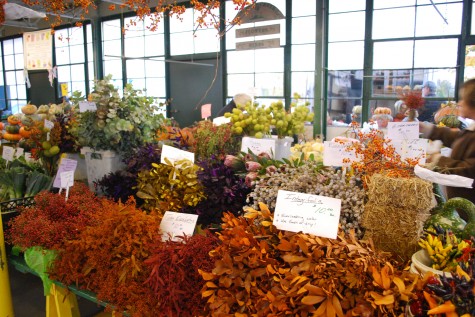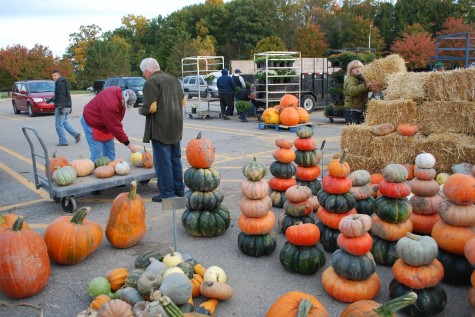The decision to commit to Dirt Simple, and write an essay every day, was a good one for me. I have enjoyed the research, the photography, the thinking through; this process has encouraged me to move beyond my own internal life to a more organized, verbal, and friendly think/speak/hear. There are so many great gardeners out there-I could not be more pleased to be meeting you. Janie in Texas, and Serena in Tuscany, and JS Hawthorne, and Bangchik in Mayalsia, to name a few-I am a member of your group. Rochelle Greayer from Studio G-I read her every day without fail. Jane-people are starting to think you are my Mom!! I so treasure my new community.
The fact of the matter-this Monday morning I had three projects in simultaneous process that needed my attention. My initial Monday essay issued about noon skipped over the salient details; would that I could be in two places at one time-but I have never been good enough to make that work. Sorry! Should you have a mind to reread my annotated, updated, rewritten late in the day, proofread and thought over Monday post – thank you much. Deborah
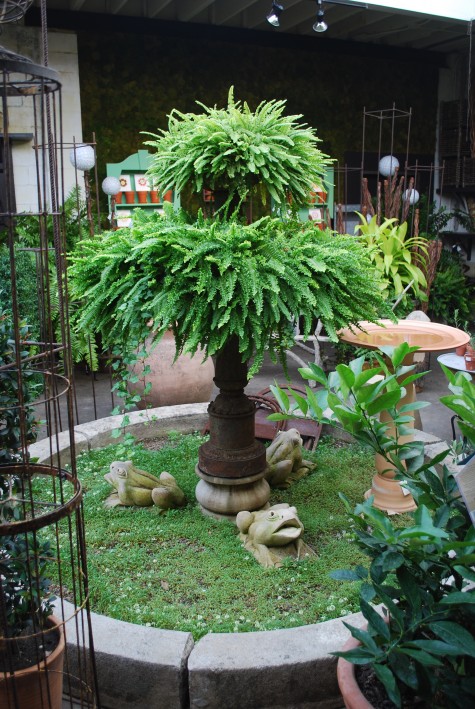 As fond as I am of ferns for shady spots in a perennial garden, there are plenty of tropical species too handsome to pass up. I have a client whose pair of Australian tree ferns flank her front door every summer; they have spent the winter in the greenhouse for the past six years. On a smaller scale, Victorian parlor ferns and Boston ferns prosper in a shady spot outdoors over the summer, and make a decent show in a cool light place indoors over the winter. Every fall we fall heir to a number of plants clients have no place for, but can’t bear to compost. Won’t we take them? Try as I can, I can’t say no to a plant in need of a home. Added to these were a number of ferns Rob grew in pots at home this year. As the dwarf crested ferns we planted 2 years ago in this antique French fountain are clearly very happy, Rob decided a fernery was in order.
As fond as I am of ferns for shady spots in a perennial garden, there are plenty of tropical species too handsome to pass up. I have a client whose pair of Australian tree ferns flank her front door every summer; they have spent the winter in the greenhouse for the past six years. On a smaller scale, Victorian parlor ferns and Boston ferns prosper in a shady spot outdoors over the summer, and make a decent show in a cool light place indoors over the winter. Every fall we fall heir to a number of plants clients have no place for, but can’t bear to compost. Won’t we take them? Try as I can, I can’t say no to a plant in need of a home. Added to these were a number of ferns Rob grew in pots at home this year. As the dwarf crested ferns we planted 2 years ago in this antique French fountain are clearly very happy, Rob decided a fernery was in order.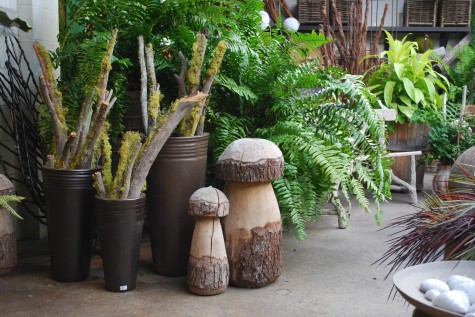 Once Rob gets a theme going, he has a sure hand putting a vignette together. The fern collection is kept company with lichen encrusted sticks from Oregon and carved wood mushrooms from Belgium. The giant fronds of what we call Macho ferns from his yard arch out some 30 inches, and cascade gracefully to the floor. We have turned on our heat, but an industrial building from the 1940’s heated with old Modine greenhouse furnaces stays decidedly cool.
Once Rob gets a theme going, he has a sure hand putting a vignette together. The fern collection is kept company with lichen encrusted sticks from Oregon and carved wood mushrooms from Belgium. The giant fronds of what we call Macho ferns from his yard arch out some 30 inches, and cascade gracefully to the floor. We have turned on our heat, but an industrial building from the 1940’s heated with old Modine greenhouse furnaces stays decidedly cool. A chartreuse dracaena named “Janet Craig” that grew vigorously over the summer in an oak barrel is brought inside. Its fountain like habit of growth is fern like, but the texture much more simple and dramatic. I find shade loving tropicals are indispensible for growing shade containers that are fresh and lively-different than the usual. This plant will winter well here; it will make a fine centerpiece for a shade pot next summer.
A chartreuse dracaena named “Janet Craig” that grew vigorously over the summer in an oak barrel is brought inside. Its fountain like habit of growth is fern like, but the texture much more simple and dramatic. I find shade loving tropicals are indispensible for growing shade containers that are fresh and lively-different than the usual. This plant will winter well here; it will make a fine centerpiece for a shade pot next summer. A pair of woven wood chairs and a table are drawn up to the fountain wall covered in baby tears. The elements of water and moss add to the woodsy look of a fern room. I cut a hole in the ceiling here large enough to handle the roof of an old Lord and Burham greenhouse. A shop devoted to all things garden would seem lacking without water, and a space to grow plants.
A pair of woven wood chairs and a table are drawn up to the fountain wall covered in baby tears. The elements of water and moss add to the woodsy look of a fern room. I cut a hole in the ceiling here large enough to handle the roof of an old Lord and Burham greenhouse. A shop devoted to all things garden would seem lacking without water, and a space to grow plants. As the room starts to fill up with plants, the space begins to feel like a conservatory. It is no wonder people go to great trouble and expense to have glass houses, or grow lights in the basement. I perfectly understand that feeling of being shut in, once I am shut out of the garden. These ferns make me think about having plants at home over the winter.
As the room starts to fill up with plants, the space begins to feel like a conservatory. It is no wonder people go to great trouble and expense to have glass houses, or grow lights in the basement. I perfectly understand that feeling of being shut in, once I am shut out of the garden. These ferns make me think about having plants at home over the winter. 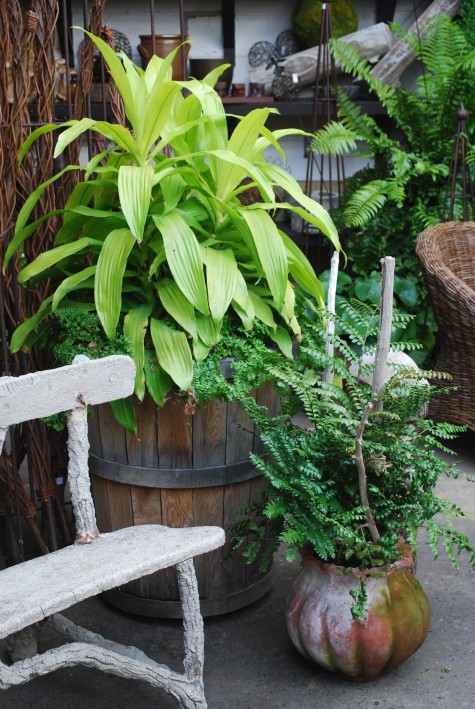
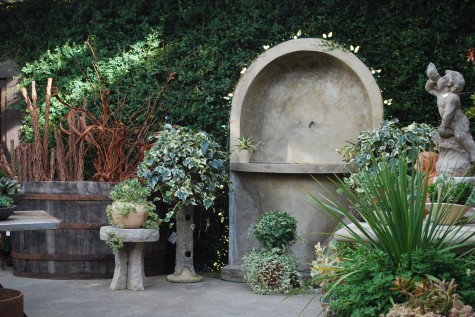 We find a home for the other bits as well. A pair of variegated Algerian ivies are so striking in a pair of old faux bois planters. A spike encircled with Cuban oregano organizes a collection of small agaves and echeverias; Rob is calling this the arid zone. An old varigated ivy single ball topiary in need of a haircut will get a winter home somewhere in this room. The climbing fig that covers the walls completes the green picture.
We find a home for the other bits as well. A pair of variegated Algerian ivies are so striking in a pair of old faux bois planters. A spike encircled with Cuban oregano organizes a collection of small agaves and echeverias; Rob is calling this the arid zone. An old varigated ivy single ball topiary in need of a haircut will get a winter home somewhere in this room. The climbing fig that covers the walls completes the green picture. 

